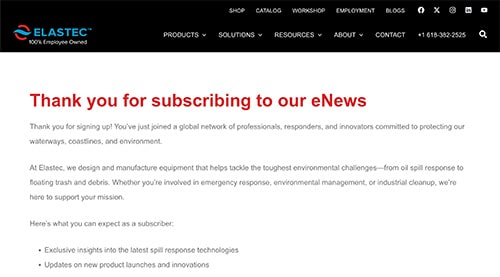What Are the Proper Storage Procedures for Containment Booms?
Proper storage is one of the most important—and often overlooked—steps in a comprehensive spill response plan. An oil containment boom is only as effective as its condition when deployed. A poorly stored boom can fail during a spill emergency, leading to environmental damage, regulatory fines, and unnecessary cleanup costs. By following best practices and leveraging purpose-built equipment like Elastec Boom Reels, Trailers, and Containers, you can extend the life of your booms and ensure they are ready for immediate use.
Why Proper Storage Matters
Oil containment booms are typically deployed in high-pressure situations, where time and performance are critical. If a boom is tangled, degraded, or contaminated, its ability to contain oil effectively is compromised. Improper storage can lead to:
- UV degradation – Direct sunlight breaks down boom fabrics over time, reducing strength.
- Mildew and mold growth – Moist environments can deteriorate materials and create health hazards.
- Punctures and tears – Contact with sharp objects or chemicals during storage can damage the boom.
- Rodent damage – Nesting animals can chew through sections of boom, rendering them unusable.
By investing in proper storage solutions and following best practices, operators can avoid costly replacements and maintain a state of readiness for rapid deployment.
Best Practices for Storing Oil Containment Booms
1. Keep Booms Clean and Dry
Before storing, booms should be thoroughly decontaminated to remove oil, debris, or saltwater that can cause corrosion or material breakdown. Allow them to dry completely in a shaded, well-ventilated area to prevent mildew and mold growth.
2. Protect from Sunlight and Weather
Booms should be stored out of direct sunlight whenever possible. UV radiation weakens the fabric over time, reducing its durability. Indoor storage is ideal, but if outdoor storage is necessary, use a UV-resistant cover or Elastec’s containers to protect the equipment.
3. Elevate and Isolate
Booms should not be stored directly on the ground. Elevating them on racks or on boom reels prevents moisture accumulation, rodent infestation, and accidental contact with sharp objects. For long-term storage, placing rat poison or other deterrents nearby is recommended to keep pests away.
4. Avoid Twists and Knots
For booms with continuously connected sections, proper folding and winding are essential. Twisted or tangled sections can cause deployment delays during an emergency. Elastec’s Boom Reels are designed to store booms neatly and dispense them quickly, minimizing the risk of entanglement.
5. Inspect Regularly
Storage is not a “set it and forget it” step. Regular inspections help identify issues such as fabric wear, missing connectors, or pest damage before they compromise deployment. Document inspections as part of your facility’s spill response plan.
Elastec Equipment for Proper Boom Storage
Elastec offers several innovative solutions that make proper storage easier and more efficient:
- Boom Reels: Designed to store and deploy hundreds of feet of boom quickly, keeping sections organized and free of twists. Reels can be powered for fast retrieval, saving valuable time during recovery operations.
- Boom Trailers: Provide a mobile, ready-to-go storage solution for facilities that require quick deployment capability. Trailers can be staged near waterways or remote spill-prone areas.
- Containers: A secure and weather-resistant storage option, ideal for long-term storage and transport. Containers protect booms from UV exposure, moisture, and physical damage.
By pairing best practices with Elastec’s purpose-built equipment, responders can maintain a high level of spill preparedness while extending the service life of their oil containment booms.
Storage as Part of Emergency Preparedness
Proper boom storage should not be viewed as a mere logistical step but as an essential element of a comprehensive spill response strategy. A boom that is ready for deployment—clean, untangled, and structurally sound—can mean the difference between a contained incident and a major environmental disaster. Facilities that invest in proper storage procedures and equipment are better positioned to meet regulatory requirements, avoid downtime, and respond swiftly to spills. In short, proper storage is not just about protecting equipment—it’s about protecting the environment and your organization’s bottom line.
Connect With Us
Sign up for our newsletters to receive the latest news and product information from Elastec.


